In the Moment:
Michael Frye's Landscape Photography Blog
by Michael Frye | Nov 29, 2015 | Night Photography
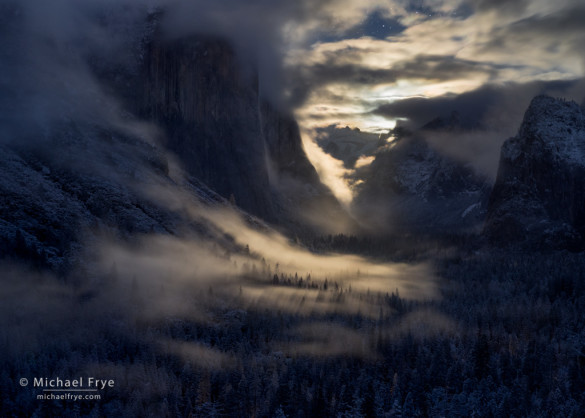
Clearing storm by moonlight, Yosemite, Wednesday evening.
Last week another storm brought rain and snow to Yosemite. We didn’t get a lot of precipitation, but after the cold front passed through, snow levels dropped down to near 3,000 feet, and Yosemite Valley received about two inches of snow.
Checking the satellite images online Wednesday afternoon it looked like the skies might clear before sunset, so I headed up to Yosemite Valley. It didn’t quite happen; I saw some breaks in the clouds, and faint sunlight hitting Sentinel Rock, but that was all. However, I knew that the nearly-full moon was due to rise about 20 minutes after sunset, so I headed up to Tunnel View to see if the skies might clear in time for the moonrise.
(more…)
by Michael Frye | Dec 7, 2014 | Yosemite Photo Conditions
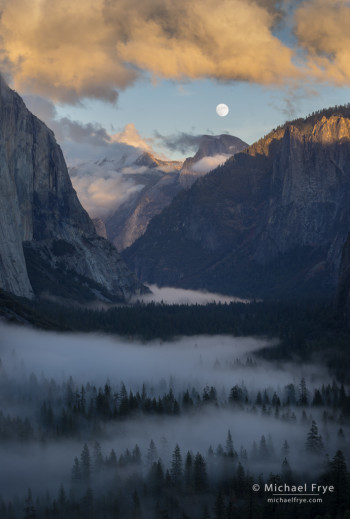
Moon rising above Yosemite Valley from Tunnel View, Thursday evening
Last Thursday evening the moon was due to rise in an interesting spot. I checked PhotoPills and The Photographer’s Ephemeris, and it looked like you’d see the nearly-full moon rise right over Half Dome if you were standing at Tunnel View. But I wasn’t sure the moon would be visible, as there were a lot of clouds.
On Tuesday and Wednesday most of California had received a good soaking – the biggest storm the state has seen in two years. Yosemite Valley got about 1.4 inches of rain, and a foot or two of snow above 8,000 feet; a decent amount, and enough to get the waterfalls flowing again, but some areas to the north and south got much more precipitation. The drought is far from over, as we need many more storms like this just to reach average rainfall levels for the winter. But it was a good start.
The storm started to clear early Thursday morning, so I drove up to Tunnel View for sunrise. It was too cloudy at first, but then the sun broke through and hit El Cap, and some beautiful sunbeams appeared to the right of Cathedral Rocks (see the image below).
Since I had some business in the valley that afternoon, I hung around, napping in my car and working on my laptop. During my meeting later I kept checking the satellite images and webcams on my iPhone, but it looked like there were a lot of clouds. We took a break at 3:45 p.m., so I stepped outside, and the weather actually looked more promising. The clouds were broken, with shafts of light reaching the cliffs. Even if the moon didn’t appear, it could be an interesting sunset. Gotta go!
(more…)
by Michael Frye | Aug 14, 2014 | Night Photography
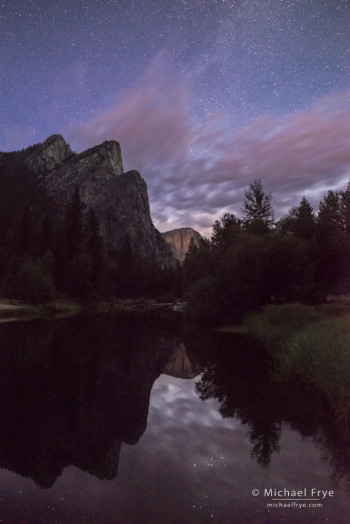
Stars and clouds over Three Brothers, Tuesday evening; 20 seconds, f/2.8, 6400 ISO
Tuesday evening Claudia and I drove to Yosemite Valley. The moon was due to rise about 90 minutes after sunset, so I hoped to photograph the northern end of the Milky Way over Three Brothers, with the rising moon adding a bit of light to the peaks.
We got to the Valley well before sunset, but there were some interesting clouds, so we decided to head to Tunnel View, where we found the usual August assortment of tour buses and people taking selfies in front of the panorama. I photographed some interesting patterns of dappled sunlight and clouds, then, just at sunset, after the crowds had thinned, the sky turned pink and a beautiful array of tufted clouds drifted overhead (below).
We had a little picnic along the Merced River as we waited for the sky to get dark, then I started taking photos of Three Brothers. At first the clouds blocked most of the stars. But the sky gradually cleared, revealing more stars, and then, looking at the photos on my camera’s LCD screen, I could see the clouds taking on a pink hue, and a hint of light on Yosemite Point in the distance. This was the lunar equivalent of a predawn glow, with the moon still below the horizon, but already adding some light and color to the scene. My eyes couldn’t see the color, but the camera could (right).
Later, as the moon rose for real, the clouds and peaks turned gold, just as they would at sunrise. Again, it was too dark for the cones in my retinas to pick up the color, but the camera recorded it perfectly. And some of the cloud formations were spectacular, fanning out in big V shapes above Three Brothers (below).
(more…)
by Michael Frye | Jan 19, 2014 | Yosemite Photo Conditions
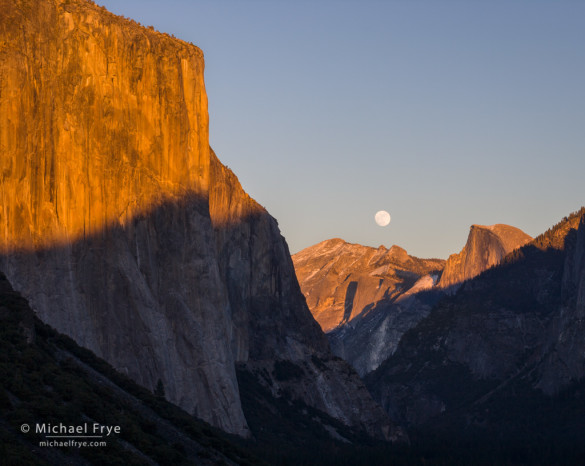
Moonrise from Tunnel View, Yosemite NP, CA, USA
During my Landscapes in the Digital Darkroom workshop last week for The Ansel Adams Gallery we photographed two moonrises, including this one on Tuesday from Tunnel View. The moon appeared right over Cloud’s Rest, between Half Dome and El Capitan, just before sunset – a spectacular sight. I’ve included two versions here: a black-and-white image just as the moon climbed into view (below), and a color version when the moon rose a little higher (above).
(more…)
by Michael Frye | Dec 13, 2013 | Photography Tips, Yosemite Photo Conditions
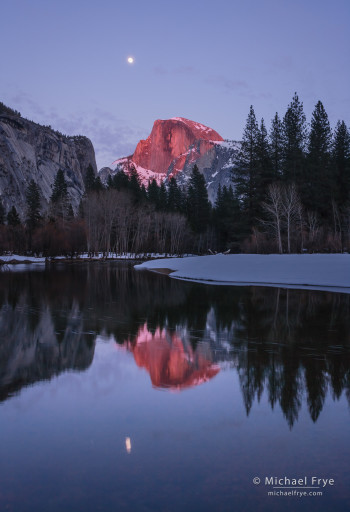
Half Dome and moon at sunset, February 18th, 2008
There’s something magical about the moon. Putting the moon in a photograph adds a sense of mystery and timelessness, and can elevate an otherwise ordinary scene into something special. Ansel Adams confessed to being “moonstruck,” and I suppose I am too.
The moon will be full next Tuesday (at 1:28 a.m. here on the west coast), and I’m sure many photographers will be trying to capture a rising or setting moon during the coming days, so I thought I would share some ideas about photographing the full moon, and clear up some misconceptions.
Misconception #1
One misconception is that moonrise or moonset photos are taken at night. They’re not: they’re almost invariably made near sunrise or sunset. After dark the contrast between the moon and the landscape is too great, and a good exposure for the moon will make the landscape completely black, while a good exposure for the landscape will wash out the moon. Around sunrise and sunset it’s possible to balance the light between the moon and the landscape and get detail in both, yet have a dark enough sky for the moon to stand out clearly.
Misconception #2
Another misconception is that moonrise or moonset photos are made on the date when your calendar says “full moon.” This can work if the terrain is flat, or you’re at a high vantage point. But if there are mountains or ridges blocking your view of the horizon, you’re better off photographing a moonrise one to three days before the full moon, and a moonset one to three days after the full moon. While the moon won’t technically be full, it will look full enough, and be in a better position than on the actual full moon night. Here’s why:
(more…)













